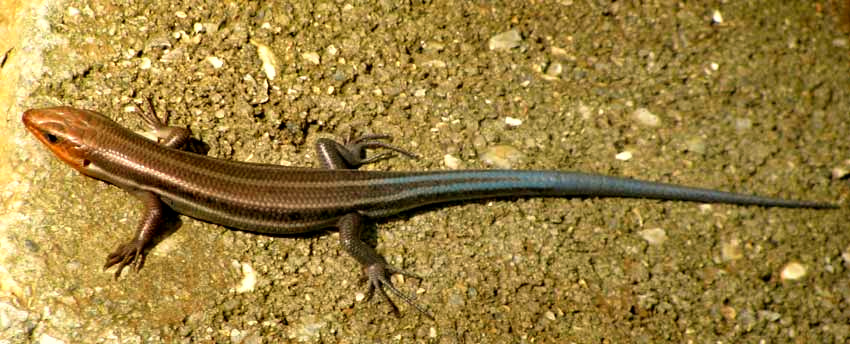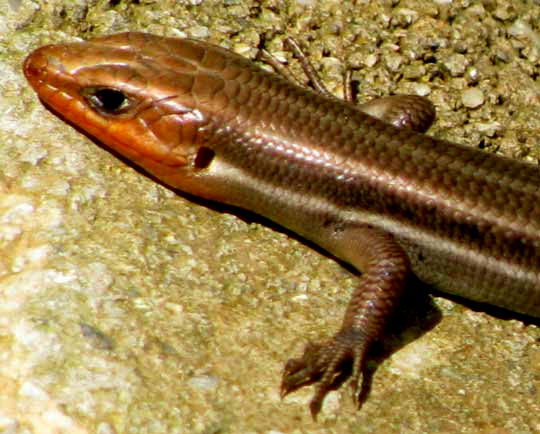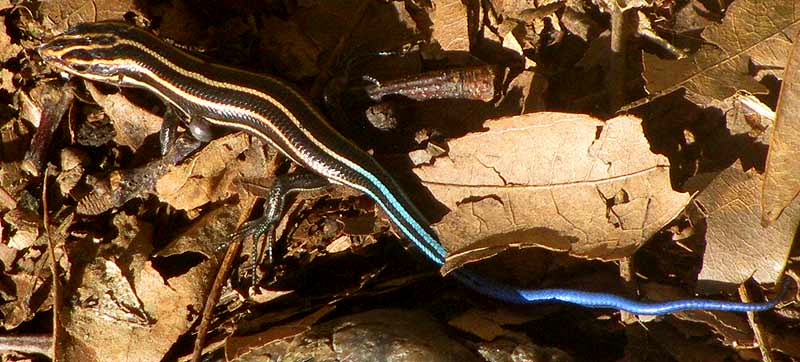Excerpts from Jim Conrad's
Naturalist Newsletter

from the April 15, 2012 Newsletter issued from the woods of the Loess Hill Region a few miles east of Natchez, Mississippi, USA
FIVE-LINED SKINK
As with Green Anoles, there are skinks all over the place here, stalking across piles of firewood and browsing among dried, brown leaves. You can see a six-inch (15cm) skink basking on a concrete block above.
You'd think that with such an amber-colored throat and blue tail the critter would be easy to identify, but actually he's a challenge. In southwestern Mississippi adult males of the Five-lined Skink, the Southeastern Five-line Skink and the Broad-headed Skink all can have that combination of features. The color forms overlap among the species, so comparing pictures on the Internet doesn't work.
My old Audubon guide to reptiles and amphibians does make a distinction regarding the top of the two pale lines along the skinks' sides, though: On the Five-lined Skink the line occupies the 3rd and 4th scale rows counting from the middle of the back; on the Southeastern Five-lined Sink the line is on the 5th, or else the 4th and 5th, and; on the Broad-headed Skink it covers the 4th scale row. Now look at a closer head-shot of our skink below:

It appears to me that the line occupies the 3rd and 4th scale rows, which points to the Five-lined Skink, PLESTIODON FASCIATUS, formerly Eumeces fasciatus. That species would make sense, since the other two are less likely to be found around houses, where this one showed up. During my hermit times in a more woodsy environment my common skink was the Broad-headed one.
I read that Five-lined Skinks are mostly terrestrial and that they feed on insects and their larvae, spiders, earthworms, crustaceans, and even other lizards and small mice.
from the July 22, 2012 Newsletter issued from the woods of the Loess Hill Region a few miles east of Natchez, Mississippi, USA
JUVENILE WITH A TICK
In bright early-morning sunlight, in the tulip bed down on the leaf litter, a slender, six-inch long (15cm), blue-tailed skink prowled about pausing from time to time to soak up the sunlight. I was tickled to see him, but also I knew he was a challenge. The challenge was that now I had to get close enough to get a picture on which I could count the lines of tiny scales covering his body. You can see the resulting image below:

The reason the skink's scale lines needed to be counted is that here in southwestern Mississippi we have the Five-lined, Southeastern Five-lined and Broad-headed Skinks, all whose juveniles are slender and blue-tailed, just as in the picture. Without examining technical details in a captured skink, the only way I know to be sure which species is at hand is to count the scales between the middle of the back and the first white line on the side.
Best I can count, the top white line on this skink's side occupies the third and fourth scale rows. If that's true, here we have the Five-lined Skink, EUMECES FASCIATUS. You can see an older individual we documented here this April at the top of this page.
On our juvenile's picture, notice the dark brownish-gray, shiny, egg-shaped tick stuck to the skink's body behind the front leg.
Nowadays much attention is being paid to the matter of ticks on lizards, for it's thought that sometimes lizard ticks play a role in spreading Lyme disease. One mystery being studied now is why, since we have so many deer ticks here in the Deep South -- which presumably can carry Lyme disease -- the disease is predominantly a problem in the Northeastern, Mid-Atlantic and Upper Midwest states. It would be nice to find that our southeastern skinks have something in their bodies toxic to Lyme Disease pathogens.